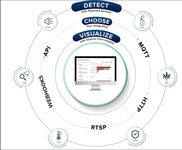The tools used to detect AI-generated material have become increasingly sophisticated. AI detectors have become more popular than ever in schools, universities, publishing platforms, and on job applications. As technology advances, a big question is always raised:
Can you beat AI detectors in 2025?
Let’s break it down — how AI detectors work, how people attempt to bypass them, and what’s ethical (and not) in this digital arms race.
What Are AI Detectors?
AI detectors can be used to determine whether a piece of content (text, image, audio or video) has been created by humans or by artificial intelligence.
In 2025, most detectors use a combination of:
- Linguistic pattern analysis
(e.g., sentence structure, word frequency, predictability)
- Watermarking or invisible markers
(especially in AI-generated images and newer language models)
- Token probability models
(measuring the likelihood that a text will be generated by a model of language)
In 2025, popular AI detectors will include Undetectable.ai and GPTZero as well as Turnitin AI Detection and OpenAI's internal classification systems.
Can You Beat AI Detectors? Technically, Yes.
But How?
Let’s explore the techniques people use to "beat" AI detectors — though not all are ethical or effective.
1. Human Editing / Paraphrasing
- How it works: The AI text is manually rewritten to alter the sentence structure, tone and phrasing.
- Effectiveness: High. Light editing can significantly lower AI probability scores.
- Limitation: The detection sensitivity of the detector may affect how long it takes to flag a signal.
2. Using Humanizing Tools
- Tools like: Undetectable.ai, WriteHuman, and AI Humanizer.
- How it works: These tools take AI-generated content and rewrite it to mimic human-like unpredictability.
- Effectiveness: Mixed. Some detectors can still flag altered content, especially if the core structure remains too "robotic."
3. Chunking or Mixing AI + Human Content
- How it works: Combining short AI-generated segments and human-written segments will confuse pattern recognition.
- Effectiveness: Moderate. This can fool some detectors, but often creates an inconsistent tone and flow.
4. Avoiding AI “Tells”
AI often exhibits traits like:
- Use of transitions (e.g. "Further," "In conclusion")
- Repetitive phrasing
- Lack of personal experience or emotion
By adding personal anecdotes, opinions, or natural errors, people can make content seem more human.
Ethical Considerations: Should You Try to Beat AI Detectors?
Just because you can doesn’t always mean you should.
Beating AI detectors may cross ethical lines when:
- Students use AI to write essays and then pass them off as their own work.
- Job seekers submit AI-generated resumes and cover letters without disclosing.
- Writers or researchers publish AI content as original thought.
On the other hand, ethical use may include:
- AI can be used as a tool for drafting and then refining manually.
- Label AI-assisted material in a transparent manner.
- Learning from AI suggestions while writing your own original material.
In professional and academic settings, integrity matters more than beating a system.
Detectors Are Getting Smarter
In 2025, detection tools will be far more advanced than they were just a year or two ago. Here's what's new:
- AI watermarking by default: Many new AI models embed invisible tags into text or images.
- Multimodal detectors: Some systems now evaluate not just text, but behavior — such as typing speed or copy-paste patterns.
- Cross-checking with databases: AI detectors can compare your work with a massive pool of known AI outputs.
While it is still possible to "beat some tools", the window of opportunity to do so is getting smaller, and the consequences for being caught are increasing.
So, What’s the Best Approach?
The smartest and most sustainable strategy in 2025 is:
- Use AI as a collaborator, not a crutch.
- Edit, personalize, and add your voice.
- Be transparent when necessary — it builds trust.
Focusing on creativity and authenticity will help you avoid detection flags, as well as set you apart from other students, professionals, or content creators in an AI-driven world.
Final Thoughts
You can beat AI detectors until 2025, but not before. As AI and detection technologies evolve, this gap is rapidly closing. Consider how you can use AI ethically, productively, and creatively, rather than race against it.
AI can be a great assistant, but shouldn't become your identity.
Media Info
Connect Person: Christian Perry
Organizations: Undetectable
Email: [email protected]
Website: https://undetectable.ai/
Country: United States






